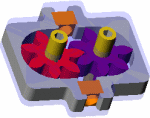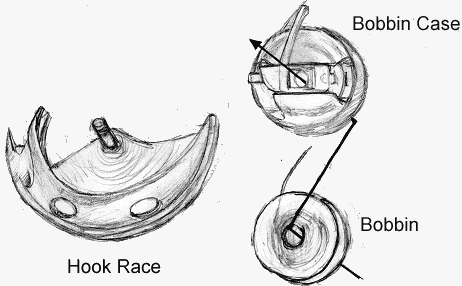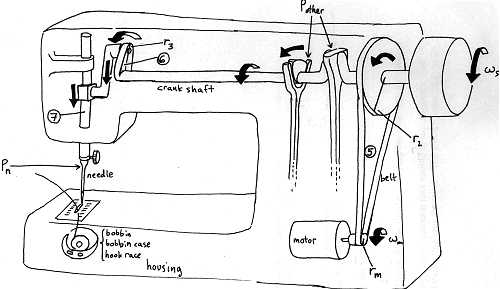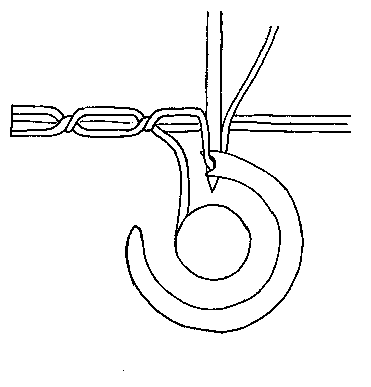 |
 |
| HOW A STICHING MECHANISM IN A SEWING MACHINE WORKS | ||
| QUESTIONS OR COMMENTS | ||
 |
AUTHOR: | Jonah Elgart |
| E-MAIL: | bologna@mit.edu | |
| COURSE: | 13 | |
| CLASS/YEAR: | 2 | |
MAIN FUNCTIONAL REQUIREMENT: To stitch thread on fabric
DESIGN PARAMETER: Sewing Machine Stitching Mechanism
GEOMETRY/STRUCTURE:
|
|||
| Detail of Stiching Assembly Components | |||
| Stiching Mechanism | |||
| bobbin case | bobbin | hook race | needle |
|
|||
| Cut-Away View of Geometry of Sewing Machine Power Transmission | |||
| Sewing Machine (the components that goes from the motor to the needle and bobbin) | |||
| housing | motor | belt | crankshaft |
EXPLANATION OF HOW IT WORKS/ IS USED:
|
| Animated Operation of Stiching
Mechanism (this is sooooo cooool!!!!!!!) |
The steps of a stitch: (put the picture for each step before the corresponding explaination)
Step 1
| The fabric has two threads running through it. One thread runs through the needle from a spool and the other comes from the bobbin. The needle lowers and penetrates the fabric, carrying its thread with it. |
Step 2
 |
The needle begins to lift and forms a loop of thread on the fabric’s under side. As the hook case turns the hook approaches, catching the looped thread. |
Step 3
 |
The needle rises above the fabric. As the hook case continues to turn, it carries the loop of thread. |
Step 4
 |
The needle is still above the fabric. The hook case finishes carrying the loop over the bobbin. |
Step 5
 |
The needle’s thread is pulled taught by a lever upstream (not visible in the diagram). This action pulls the loop from the hook and thus completes the stitch. The stitch is now ready to be repeated. |
The needle:
- The main shaft is powered by a belt (5) that runs from the motor.
- At the needle end of the crank shaft is a protruding lever (6) that rotates with the shaft.
- This bar connects to the lever at one end (6) and the needle rod (7) at the other. Since the needle rod can only travel up and down, the bar transfers only the vertical movement from the lever.
- 4. The needle oscillates vertically.
DOMINANT PHYSICS:
|
| Cut-Away View of Geometry of Sewing Machine Power Transmission |
| Variable | Description | Metric Units | English Units |
| Pin | Motor power | Watt | Horsepower |
| Pfrict | Power lost to friction | Watt | Horsepower |
| Pother | Power used to drive other parts of machine | Watt | Horsepower |
| Pn | Needle power | Watt | Horsepower |
| rm | Radius at motor | meter | feet, inches |
| r2 | Radius at 5 | meter | feet, inches |
| r3 | Radius at 6 | meter | feet, inches |
| ws | Crank shaft rotational speed | rad/s | rpm |
| wm | Motor rotational speed | rad/s | rpm |
| x(t) | Vertical needle position | meter | feet, inches |
| v(t) | Vertical needle velocity | meter/s | feet/s, inches/s |
The power provided by the motor is equal to the power consumed. From this we can find the power provided to the needle.
Pin = Pfrict+Pother+Pn => Pn = Pin-Pfrict-Pother
To find the velocity of the needle we first must find the crank shaft’s rotational speed, ws. As the power at the motor equals the power at the crank shaft (assuming 100% efficiency): Pin = F * rm * wm = F * rs * ws. Since the force applied to the belt is the same force applied to the crank shaft: rm * wm = rs * ws which means ws = rm * wm / rs.
The vertical position of the needle is a function of time, x(t), that depends on the radius of the lever, r3, which protrudes from the crank shaft and its rotational speed, ws. This function is approximately a sine wave.
x(t) = r3 * sin(ws
* t) (because ws = rm * wm / rs)
= r3 *
sin[rm*wm *t/ rs]
To find the approximate velocity with respect to time, differentiate:
v(t) = r3 * (rm * wm / rs) * cos[rm * wm * t/ rs]
LIMITING PHYSICS:
None Submitted
PLOTS/GRAPHS/TABLES:
None Submitted
REFERENCES/MORE INFORMATION:
Macaulay, David. The Way Things Work; Houghton Mifflin Company, Boston: 1988
Brother vx-807 sewing machine


